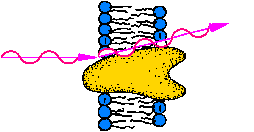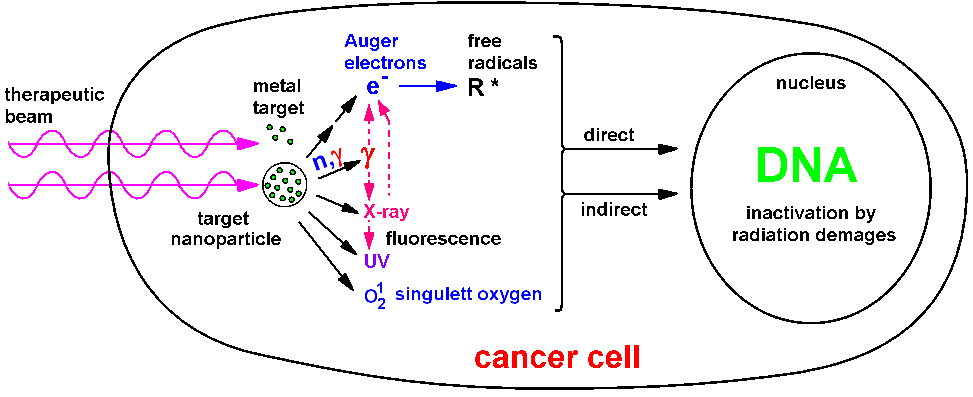 |
Nanotherapy-IRT groupResearch group coordination: Nawroth, Langguth, DeckerSpokesman: Prof. Dr. P. LangguthIRT : Indirect Radiation Therapy of Cancer |
 |
Nanotherapy-IRT groupResearch group coordination: Nawroth, Langguth, DeckerSpokesman: Prof. Dr. P. LangguthIRT : Indirect Radiation Therapy of Cancer |

Indirect radiation therapy of cancer IRT inactivates tumors cells by secondary products evolving from an incorporated target upon specific absorption of external radiation (fig.1). The method can be applied with synchrotron X-ray photons (photon activation therapy PAT, photodynamic x-ray therapy PXT), neutrons (neutron capture therapy NCT), or with surface near tumors (skin) with visible or infrared light (photodynamic therapy PDT). The principles for different types of external radiation are shown in fig.2.

Fig.2: The local specific absorption of external radiation at an incorporated target produces secondary radiation products, which kill cancer cells by DNA demage (directly or indirectly).
We have developed IRT methods using biocompatible heavy metal complexes of Lanthanides as targets, e.g. Gadolinium-, Erbium- to Lutetium-DTPA. The heavy metals are applied as key-formulations reversibly braking the blood-brain barrier BBB, or in target-nanoparticles, i.e. magnetic target liposomes and target-Ferrofluids. As external radiation we use light, synchrotron X-ray radiation at the K-edge of absorption, and cold neutrons, which are locally completely absorbed at injected 157Gd (Gd-NCT, Gd-cNCT). In the final therapy, the IRT targets will be combined with chemotherapy agents in order to exclude late metastasis.
Our IRT long term project is an institutional and international cooperation (Germany, Spain, France; at ESRF and ILL) with industrial support. During three years it shall proceed from the current animal tests and cell culture experiments to the first human applications, i.e. a novel adjuvant cancer therapy.
Involved persons and groups:
PD. Dr. Thomas Nawroth, Biochemistry Institute, Chemistry Department, Gutenberg-University, D-55099 Mainz, Germany
Prof. Dr. P. Langguth, Institute of Pharmacy, Department of Chemistry, Pharmacy and Geo-Sciences, Staudingerweg 5, Gutenberg-University, D-55099 Mainz
Prof. Dr. H. Decker, Ch. Meesters, B. Pairet, Molecular Biophysics Institute, Biology Department, Gutenberg-University, D-55099 Mainz, Germany
Prof. Dr. H. Schmidtberger, Radiooncology and Radiotherapy Clinics, University clinics, Langenbeckstr. 1, D-55131 Mainz
PD. Dr. D. Bickes-Kellerher, Institute of Physiology and Pathophysiology, Medical Department, Gutenberg-University, D-55099Mainz, Germany
Prof. Dr. M. A. Konerding, Anatomy and Cell Biology Insitute, Medical Department, Gutenberg-University, D-55099Mainz, Germany
PD. Dr. A. Alexiou, HNO, Klinik für Hals, Nasen und Ohrenkranke, University Clinics, Waldstraße 1, D-91054 Erlangen, Germany
Dr. St. Corde-Tehei, Dep. Hemato-Cancerologie-Radiotherapie, CHRU clinics, B.M. 217X, F-38043 Grenoble Cedex9, France
Dr. R. P. May, Prof. Dr. R. Gähler, Dr. B. Lauss, Dr. M. Jentschel; ILL Institute Laue-Langevin; BP156, F-38042 Grenoble Cedex, France
PD. Dr. A. Bravin, E.S.R.F.,BioMedical Beamline ID17, 6 rue Jules Horowitz, B.P. 220, F-38043 Grenoble Cedex, France
Dr. G. LeDuc, E.S.R.F., BMF BioMedical Facility, ID17, 6 rue Jules Horowitz, B.P. 220, F-38043 Grenoble Cedex, France
Prof. Dr. M. Sabés, M. Costa-Torres, Dep. de Bioquimica, Facoldad de Medecina, Universitat Autonoma de Barcelona, E-08193 Bellaterra (Barcelona), Spain
References:
(1) T. Nawroth, M. Rusp, R.P. May; Physica B 350 (2004), e635-638 "Magnetic liposomes and entrapping : time-resolved neutron scattering TR-SANS and electron microscopy"
(2) T. Nawroth, et al.; ESRF User meeting 2006, Grenoble 2.2006, proceedings (3 contributions on indirect radiation therapy IRT using synchrotron radiation) :
2a) "Indirect radiation therapy with target Nnanoparticles" poster-handout Nanotherapy1
2b) "Therapeutic Imaging and Indirect Radiation Treatment IRT with Target Nanoparticles for Cancer Therapy at ESRF-ID17" abstract Nanotherapy2
2c) "Target Nanoparticles for Cancer Therapy : Structure Investigation by SAXS, SANS, ASAXS, DLS and Electron Microsopy" abstract Nanotherapy-Targets / Nanotherapy3
(3) T. Nawroth, B. Pairet, H. Decker, St. Corde, B. Lauss, M. Jentschel, R.P. May (2006) "Perspectives of Neutron Capture Therapy of Cancer with Gadolinium and cold Neutrons (Gd-NCT)"; DGfB2006, Conference of the German Biophysics Conference, Mainz, 24.-27.9.2006; proceedings - abstract P74
(4) T. Nawroth, et al.; SNI2006, Conference on science with synchrotron, neutron and ion beam facilities; proceedings (3 contributions on indirect radiation therapy IRT) :.
4a) "Indirect Radiation Therapy of Cancer by Neutrons and Synchrotron Radiation" abstract Indirect Radiation Therapy 1 talk-title Indirect Radiation Therapy 1
4b) "Indirect Radiation Therapy of Cancer with Synchrotron Radiation at the K-Edges of Heavy Metal Complexes and Target-Nanoparticles" abstract Indirect Radiation Therapy 2 poster-handout Indirect Radiation Therapy 2: PAT
4c) "Indirect Radiation Therapy of Cancer by Neutron Capture at dense Gadolinium Targets (Gd-NCT)" abstract Indirect Radiation Therapy 3 poster-handout Indirect Radiation Therapy 3: NCT